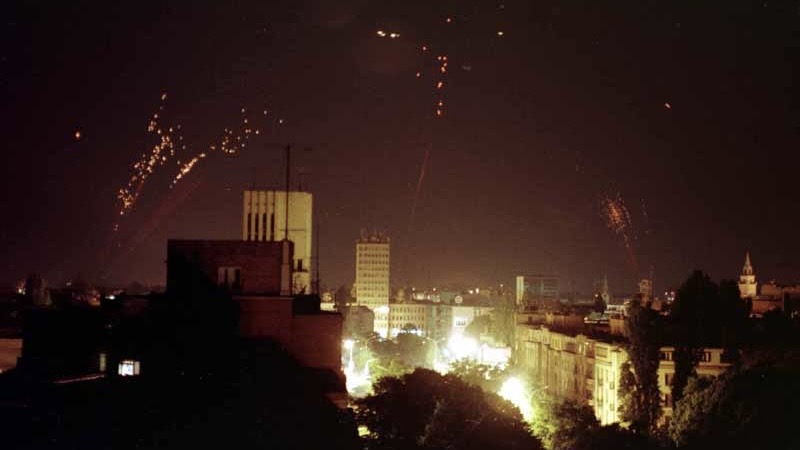[The ongoing war in Ukraine and the prominent role that the North Atlantic Treaty Organization (NATO) has played in provoking the escalation, has prompted many to look at the history of the organization and the role it has played in a series of bloody wars since its inception. One contemporary example within Europe itself was the Yugoslav wars.
Marco Siragusa of Meridiano 13 participated in an episode of Eat NATO For Breakfast with Peoples Dispatch to discuss the history of the Yugoslav wars, the impact on the Balkan region, and the role of NATO. He summarized his comments in the following piece.]
The fall of the Berlin Wall and the disintegration of the Soviet Union had deluded many, convinced that a period of peace and prosperity would come. The nineties were instead a decade of wars, from the Gulf War to the most violent and bloody wars in the Balkans between 1991 and 2000.
To understand what happened in those years we need to put the Yugoslav wars in the right context. Since the breakup between Tito and Stalin with the expulsion of Yugoslavia from the Cominform in 1948, relations between Yugoslavia and the Soviet Union have often been confrontational. However, this did not mean an alliance with the West, despite good relations with some countries of the capitalist bloc.
Tito and the Yugoslav Communist Party were able to maintain some stability among the various components of the Socialist Federal Republic of Yugoslavia, which consisted of six republics (Slovenia, Croatia, Bosnia and Herzegovina, Serbia, Montenegro, and Macedonia), and two autonomous regions in Serbia, Kosovo and Vojvodina. Economically, the country enjoyed good well-being. Even on the international level Yugoslavia enjoyed its own credibility, playing the role of “buffer state” between the two blocks. This was largely due to the creation in 1961 of the Non-Aligned Movement by Tito, together with the Egyptian President Gamal Abdel Nasser and Indian President Jawaharlal Nehru. The movement’s first summit took place in Belgrade wherein the Yugoslav leader was the first secretary.
After his death, however, in May 1980, things changed considerably. Ethnic and nationalist tensions became more and more evident and the economic crisis of the second half of the seventies had put the country in serious difficulty. The eighties were therefore a period of rebirth for the nationalist claims of the Republics, especially the richest ones (Slovenia and Croatia) that demanded greater economic autonomy.
The victory of the first post-communist parties in the 1991 elections was the prelude to the clash. Slovenia and Croatia, supported mainly by Germany and the Vatican unilaterally declared their independence from the Federation, followed shortly after by Bosnia Herzegovina. Serbia, led by Milosevic and intent on avoiding the dismemberment of the Federation, responded with war: first in Croatia and then in Bosnia-Herzegovina.
In that period two opposite phenomena manifested themselves in Europe: on the one hand the disintegration of a multi-ethnic and socialist state, on the other the birth of an international and neoliberal organization: the European Union, created by the so-called Maastricht Treaty in 1992.
In the eighties three elements merged together, creating a bomb ready to explode: the economic crisis, “identity” issues (such as religion or past relations between the peoples of the Federation) and the definitive generational change of the communist leadership. The economic difficulties were exploited by the national, post-communist and nationalist elites, who fed a hostile narrative towards neighboring peoples.
The crisis of Yugoslav socialism in the 1980s opened the door to economic reforms based on privatization and the sale of the industrial sector. The country increasingly opened up to a market economy, even making deals with the IMF. This allowed the national leaders to create a close alliance with private investors, giving rise to a true clientelistic system. Economic interests were also accompanied by political claims that tended to impose the domination of their people on others.
Serbian elites were interested in creating “Greater Serbia”, including all the territories where there were Serbian citizens. In Croatia, Franjo Tudjman, an avowed fascist, wanted to follow the path of the Independent Croatian State, a collaborationist state born during the Second World War and led by the fascist Ustaša movement. When phenomena such as the economic crisis, the loss of certainty about the future, the end of solidarity between peoples are governed by nationalist forces, the clash between nations is certain. And that is what happened in the Balkans in the 1990s.
In November 1991 the European foreign ministers decided to impose on Yugoslavia (now formed only by Serbia and Montenegro) an oil embargo accompanied by the suspension of trade relations and above all the possibility of recognizing the independence of the secessionist republics. This is a first lesson we can learn today by looking at those events: sanctions, energy embargoes, and trade interruptions, implemented even today against Putin’s Russia, do not facilitate the achievement of peace but, on the contrary, further fuel tensions between the warring parties.
US President Bill Clinton explored different avenues to engage in the war, in an attempt to initially avoid direct US and NATO intervention. The situation changed when, on February 5, 1994, Serbian troops were accused of bombing the Markale market in Sarajevo, causing 68 deaths. The city had already been under siege for 2 years and would remain so until 1996. A terrible siege that caused more than 11,000 deaths and that remains today the longest in modern history. Faced with this massacre, NATO decided to issue an ultimatum to Belgrade imposing a no-fly zone over Bosnia and Herzegovina.
The criminal action carried out in Srebrenica, where Bosnian Serb troops killed more than 8,000 Muslims with the passive complicity of Dutch UN forces, prompted President Clinton to intervene directly in the conflict with the NATO-led Operation Deliberate Force. This was an important moment in the conflict. The Western media and especially NATO used the tragedies of the war to justify their intervention to the public, presenting it as a “humanitarian intervention” to save attacked civilians. On that occasion, NATO’s participation pushed Milošević to participate in the peace negotiations in the American city of Dayton, which ended with the signing of an agreement between Serbs, Croats and Bosnians and which designed the current Bosnian institutional system.
If the first intervention of NATO in the Balkans was also formally supported by the UN to put an end to a war that had been going on for four years, much more problematic was the second military intervention of the Atlantic Alliance that took place in 1999 during the war in Kosovo. With the motivation of saving the Kosovar population from the ethnic cleansing perpetrated by Serbia, which was opposed to Kosovo’s demands for independence, NATO launched, without any formal authorization from the UN Security Council, a new military operation in March 1999: Operation Allied Force.
The targets of military operations were in fact the chemical industries such as those of Pancevo on the outskirts of Belgrade, the automotive industry such as Zastava, power plants, the main arteries such as roads and bridges. There were also numerous “mistakes” committed by NATO pilots that caused thousands of civilian deaths. Such as the NATO bombing of the Kosovar village of Korisa that caused 60 civilian deaths. It was the first time NATO used military force without the express approval of the UN Security Council. From that point on, authorizations were often expressed broadly from the initial idea, using the concept of “humanitarian warfare.” A doctrine known as the Responsibility to Protect, invoked for example by NATO to bomb Libya in 2011. NATO’s progressive involvement in global conflicts has certainly weakened the UN, unable to act as a forum for conflict resolution.
We see this again today. In the war in Ukraine, the UN has hardly intervened in any way except with long and inconclusive discussions. It can be said without a doubt that today the real arbiter of conflicts is not a political organization like the UN, which includes all the countries of the world, therefore including non-Western ones, but a military alliance of the most developed countries like NATO. The consequences are obvious to all.
Thirty years later we can try to give an answer to the question “What did the war solve?”: almost nothing from the territorial point of view. The borders of nations after the war are almost the same as in the pre-war period. Only now instead of a single multi-ethnic, socialist, internationally respected state, there are 7 countries that tend to be increasingly ethnically homogeneous (with the exception of Bosnia where all three ethnic groups are constantly present), often hostile to each other, and with reduced international weight compared to Yugoslavia.
As always, therefore, the war has not solved any problem, but rather created new ones, as demonstrated by the continuous clashes, fortunately only rhetorical for now, in Bosnia-Herzegovina. One of the most important challenges for all Balkan countries today concerns young people and emigration. For thirty years there has been a consistent process of depopulation that involves especially the youngest. Bosnia-Herzegovina has lost about 500,000 people since 1991 out of a total population of about 4 million. Almost 20%. A similar phenomenon, albeit with lower figures, concerns Croatia, a member of the EU since 2013. A demonstration that EU and NATO membership is not enough to solve the problems.
(Courtesy: Peoples Dispatch. Peoples Dispatch is an international media organization with the mission of highlighting voices from people’s movements and organizations across the globe.)




